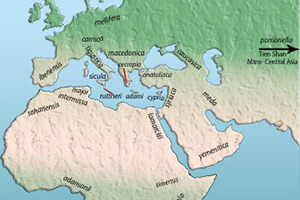
More beekeepers need to use bee stocks that do not require miticides to control varroa mites. There may be a different race, selected stock or improved queen strain that meets your needs to mate with the best of your localized survivor bees. My intention is not to eliminate anyone’s locally adapted, survivor stock. If you have that, fantastic! Instead, I am trying to reduce the introduction of bees that are not selected for much of anything and that are preventing the development of mite tolerance and long-term sustainability, or keeping colonies alive.
We will start by reviewing races of bees found throughout the Apis mellifera distribution areas: Africa, Europe and Asia. Since none of these are native to the Americas, not all of them work here. Some have been tried and rejected because of too little productivity or too much defensive behavior. The importation of all bee stocks from other countries is controlled by the U.S. government, and has been for nearly a century.
Then we will look at the more popular selections of honey bees that are being used to improve survivorship. Several have been developed in an attempt to control varroa mites and eliminate miticide use.
Honey Bee Races
Scientists estimate that there are an estimated 20,000 species of bees in the world, and the honey bee is only one of them. Worldwide, this single species is divided into 27 different races or subspecies that have adapted within their native habitat.
The concept of species is described as a number of living organisms (plants, animals, bacteria, etc.) that consist of similar individuals that are able to mate and exchange genes. Scientists use a binomial or two names in Latin to identify each species. Humans are Homo sapiens. The Western honey bee is named Apis mellifera. The first name is the genus name, which is always capitalized, and the second name is the species name, which is always lower case. If a third Latin name appears, called the trinomial, it always appears in lower case and describes a subspecies or race of that species. The Italian honey bee is named Apis mellifera ligustica.
Following the binomial and trinomial is often an un-italicized name of a person or group of people. These are the people who first collect samples of the subspecies and described it in a scientific publication. While the initial descriptions of the races of honey bees started in the 1700’s, the process continues today as DNA analysis is used to recognize additional races of bees.
By definition, all races (subspecies) of a species are able to mate and exchange genes. That means that honey bee queens and drones from distant and different continents are able to mate and will produce viable sons and daughters.
Washington State University professor Walter “Steve” Sheppard provides the latest summary of 27 races of honey bees in the 2015 edition of The Hive and the Honey Bee. He has grouped them by evolutionary lineage that follows continental geography. I summarize them here:
- African (12 subspecies)
Apis mellifera adansonii Latreille—Found in western Africa, this is a small, yellow bee. Drones may have yellow stripes on the abdomen. The bees have variable defensiveness.
Apis mellifera capensis Escholtz—Southwestern corners of Africa. Known for a high level of ‘thelytoky’, a genetic trait where unfertilized eggs develop into diploid adults (workers or queens). Because the bees are able to produce queens from unfertilized eggs, this trait is considered to be a threat to human beekeeping practices. The bees are small and dark with a slender abdomen. They have reduced defensive behavior.
Apis mellifera intermissa von Buttel-Reepen—Found in North Africa from Tunisia to Morocco. The bees are unusual in that they rear brood in the spring and fall, but not in the summer. This reflects their local floral cycle. The bees are defensive and produce over 100 queens during reproductive swarming. It is a very dark bee with less hair on their bodies. The bees were sold in the United States as the ‘Punic Bee’, but their defensiveness eliminated them from popularity.
Apis mellifera lamarckii Cockerell—The Egyptian bee, found along the Nile River, and used as a migratory bee using boats since the Pharaohs. Introduced into North America in the 1860s, genetic remnants persist in feral populations. The bees are the smallest subspecies, and bodies are slender. It has a silvery white hair on the thorax and bright orange banding on the abdomen. The bees do not adapt well to Langstroth equipment. These are the bees found in Egyptian mud-dung tube hives.
Apis mellifera litorea Smith—The bee of the eastern coast of Africa from Kenya to Mozambique. Small and highly defensive, this race demonstrates absconding behavior during nectar dearth. It hybridizes with A. m. scutellata.
Apis mellifera major Ruttner—Found only in the Rif Mountains of North Africa. The bees are larger than A. m. intermissa found within the same region.
Apis mellifera monticola Smith—Occurs in isolated forested mountains of eastern Africa, including Kilimanjaro, and the highlands of Ethiopia. The subspecies forages in cool weather and has a gentle behavior. These medium sized bees were introduced into Europe (2008) for use in breeding work.
Apis mellifera sahariensis Baldensperger—A small, yellow and docile bee with moderate swarming instincts. Used in Europe by bee breeders, including Brother Adam, who reported hybrid vigor when crossed with other races.
Apis mellifera scutellata Lapeletier— Native to the savannas of eastern and southern Africa from the Cape of South Africa to Ethiopia, this subspecies has been adapted to movable frame beekeeping. Introduced into Brazil in the mid 1950s, its swarms spread throughout South America, Central America, Mexico and into the southern United States. Considered to have crossed with …
Photo Caption
Map showing geographic distribution of honey bee (mellifera) subspecies in areas of endemism. (From p. 55 of the 2015 edition of The Hive and the Honey Bee.


